24 VASES in 24 DAYS
Design students produced a unique collection of ceramic vases for Aalto University Executive Education.
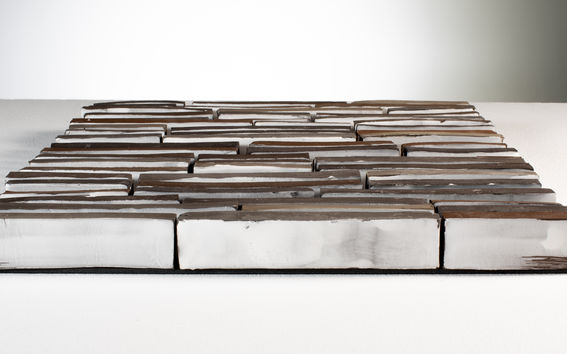
When we think of origins, what comes to mind? The brief for Product Design in Ceramics asked to design and produce an artifact that included a traditional ceramics manufacturing technique (e.g., pinching, coiling, slabbing, throwing, slip casting) as well as a 3D-printed method (delta print extrusion or stereolithography) reflecting on origins. Students explored the idea of origins from different perspectives, ranging from cultural and ethnic origins to personal histories, to the origins of humanity, Earth, and the universe.
Contemporary Design students´ exhibition ORIGINS was held in Beta Space gallery, Aalto University 22.03.-04.04.22 and in Glasshouse gallery, Aleksanterinkatu 13, Helsinki, 9.6.-20.8.2022.
Students: Vihar Kotecha, Sesilia Pirttimaa, Lennart Engels, Federico Fiermonte, Nina Naveršnik, Emilie Tuuminen, Elise Piquemal,Ruut Launo, Liv Telivuo, Anton Mikkonen, Henriikka Pahkala, Chien-Chi Kuo, Johannes Kaarakainen, Zoë Robertson, Pegah Shamloo & Juan Guevara Verjel
Teacher: Nathalie Lautenbacher
Visiting lectures: Priska Falin, Ashish Mohite, Maarit Mäkelä
Pictures: Juan Couder
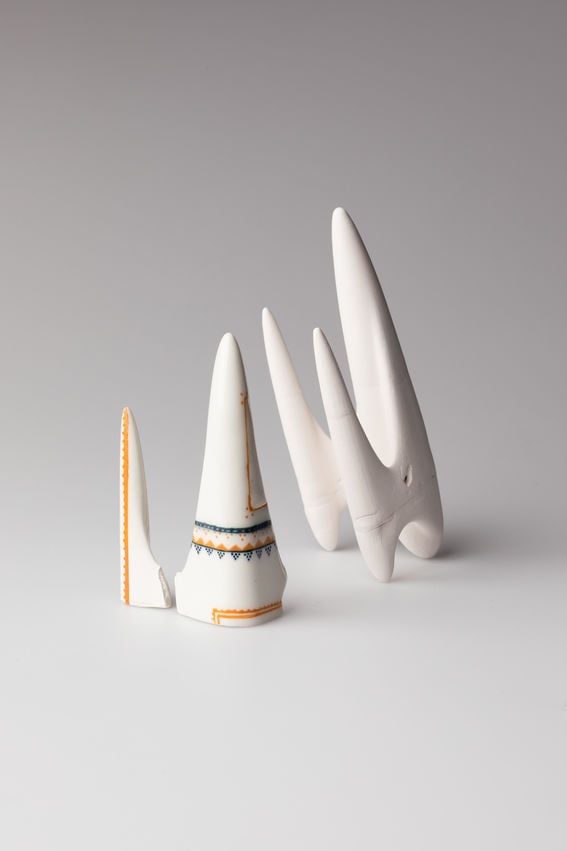
Vihar Kotecha - Vehicles of Culture
The sculptural piece showcases a juxtaposition between science fiction and tradition. An abstract outlook of my fascinations and origins.
~
It was really interesting for me to see the rooted and traditional Finnish Sami culture. The objects and artefacts gave a very primitive outlook of the culture. The garments and wearables were something that especially surprised me. I noticed that the patterns that Sami people used on their garments were very similar to the traditional wear from my culture. It is interesting to see that two disconnected cultures have so much similarity between their artefacts. Therefore, as an homage to my own culture and memories, I decided to use my own traditions as an inspiration for the treatment that is supposed to be done on the ceramic sculpture. Therefore, as an homage to my own culture and memories, I drew inspiration from my own traditions to create a pattern for the ceramic sculpture. The patterns and colours embroidered on the traditional wear of Gujarat (my state in India) is implanted in my mind as a very distinctive memory. Also, growing up being a huge fan of science fiction gave me a lot of inspiration to create my own design language. For the final sculpture, I tried to capture a fascinating juxtaposition of tradition and fiction. I created a shape that resembles the very early sketches that I used to do as a kid, refined it and sculpted it in 3D. I treated the shape as a canvas to represent my culture. Here the usage of shapes and patterns are literal but the overall representation is what creates a sense of abstraction.
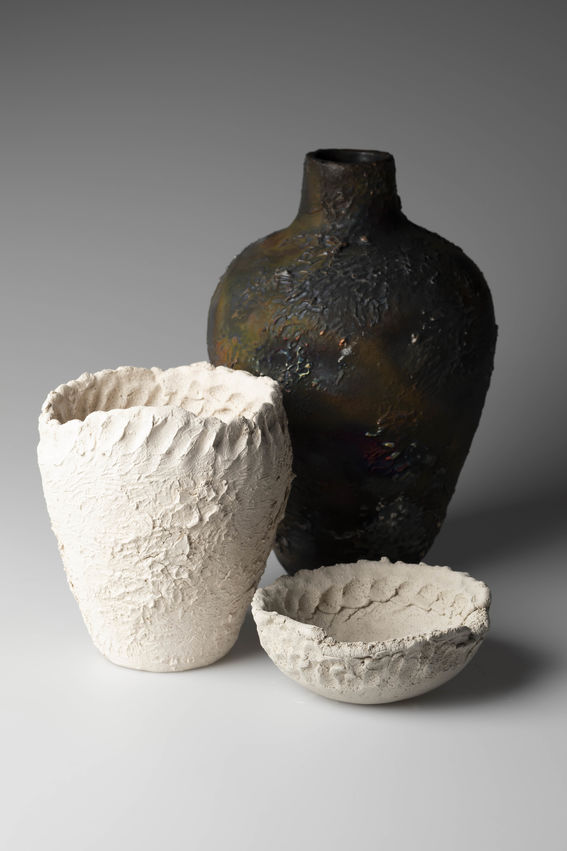
Sesilia Pirttimaa - Vähäpoika, Puoliraavas, Raavas
Three hand-built raku vases inspired by my family story of the fragility and unpredictability of life. I created these three pieces to represent the capricious nature of the states of life.
~
My great great grandfather Juho Juhonpoika (1863-1937) worked in a copper mine in Michigan. At that time, lunch was brought into the tunnels in mess kits (pakki in Finnish) to make work as efficient as possible. Juhonpoika was just starting to eat his lunch. He took the lunch bread and milk bottle from his backpack and was about to open his drink when a rat ran from the tunnel, stealing his bread. Instinctively Juhonpoika went after the rat, cursing and scolding it for stealing food, and at the very same second the tunnel walls began to break. Tons of stone fell to the place where the miners had begun their meals. The rat saved my great great grandfather’s life by stealing the meal. After all that happened, he moved back to Finland and married Alma, my great-great-grandmother. Without the rat, I wouldn’t be here now. This piece is made for the honor of that fateful rat.
The family story taught me the fragility and unpredictability of life. I created these three pieces to represent the capricious nature of the states of life. Coincidences of life are didactic for the young and corroborative for the old.
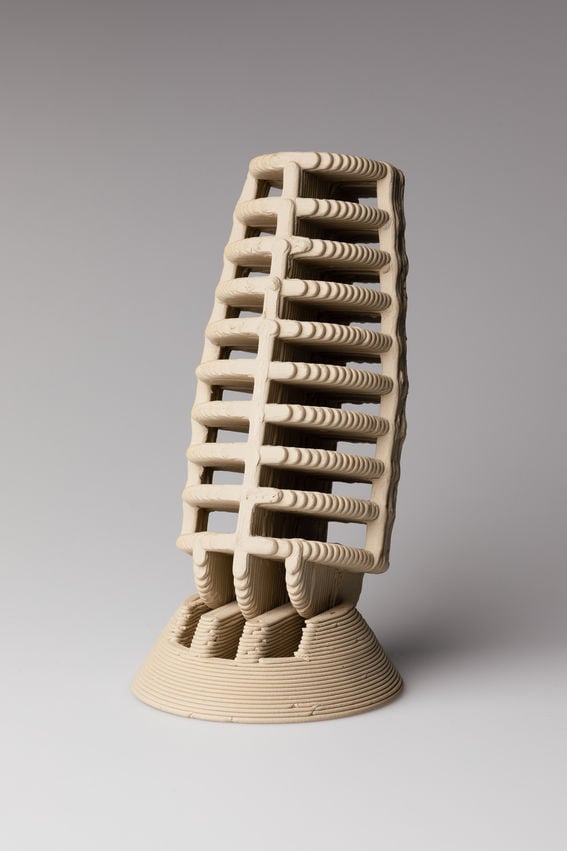
Lennart Engels - The OGs
Through memories of my grandparents, I created three kinds of sculptures exploring different ways of working with ceramics. These methods include clay 3D-printing, the assembly and joining of rocks with glaze, and the use of engobe as a medium to bring texture and color to a piece.
~
In this ongoing project I reflect on my own origins through memories of my grandparents, with the goal to explore new creative and experimental processes with ceramics.
The work consists of three categories of sculptures, each exploring different ways of working with ceramics. These methods include clay 3D-printing, the assembly and joining of rocks with glaze, and the use of engobe as a medium to bring texture and color to a piece.
Cairn represents my maternal grandmother from whom I inherited my love for hiking and mountains. The figure represents a cairn: a stone figure found in the mountains to mark a path. I always loved the idea of putting my own mark in an environment as overwhelming as the mountains - a harmless human-made mark that can only be destroyed by another human being or a strong natural power like the wind. Each stone is glued together with a transparent glaze to immortalize the cairn and to embody the memories of time spent hiking with my grandmother.
Bompa is a 3D-printed ceramic sculpture inspired by one of my grandfathers. The architectural sculpture represents my grandfather, an engineer, and how he inspired me to become a designer. The piece explores the limits of the 3D-printing process, generating a visual language that emphasizes the layered aesthetic of the process.
Rosa represents my paternal grandmother. I remember her as a warm and welcoming person who taught me how to express myself through creativity. The piece is a primitive abstraction of a human figure; expressing warmth and welcoming. Colored engobe is applied to the surface in layers to create a colorful texture that melds with the clay.
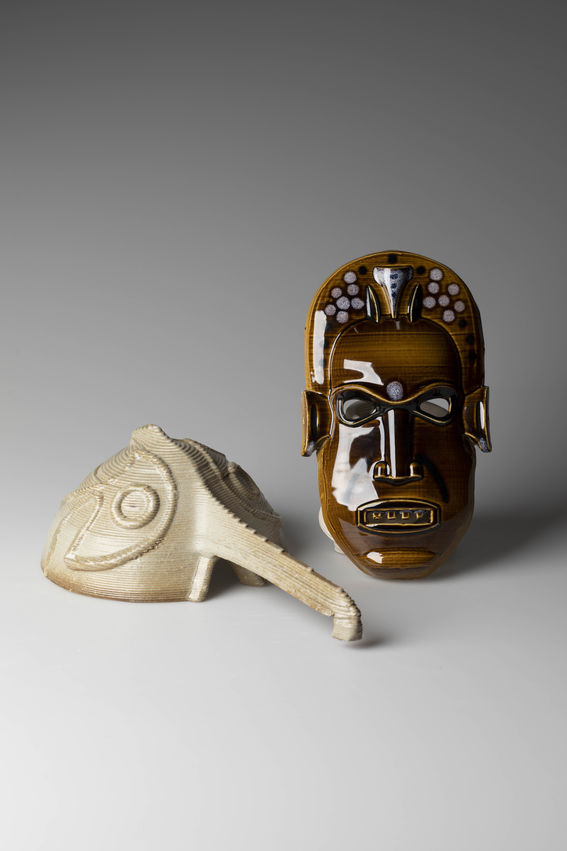
Federico Fiermonte - Primordial Portraits
This series consists of four different types of masks, each of which is inspired by specific geographical areas in Europe, Africa, America and Oceania. The masks are made using different methods (slip-casting and 3D-printing) and glazes to resemble materials or decorative aspects typical to these cultures.
~
The theme ‘Origins’ led me to retrace the past of my grandparents’ and parents’ lives who, having lived in a period of economic prosperity in Italy, had the opportunity to live in different countries in the most different corners of the globe: the United States, South Africa, Belgium, Australia, Brazil, and Morocco.
Of all these experiences, one of the most present witnesses left in my native home in Rome are certainly the many, ancient and extravagant tribal masks collected between Africa and Australia.
I found in this highly descriptive object of a culture, of a society - the mask - a great potential for experimentation with ceramics.
I then took the four continents where my family lived and designed a mask for each of them, creating different samples for each type to leave ample space for the final chromatic testing. Taking as inspirations the decorations of the Native American masks, the fabrics of the Australian tribal masks, the wood, the engravings of the African ones and the metal of the Roman one, I created a different result in each mask to get closer to these characteristics.
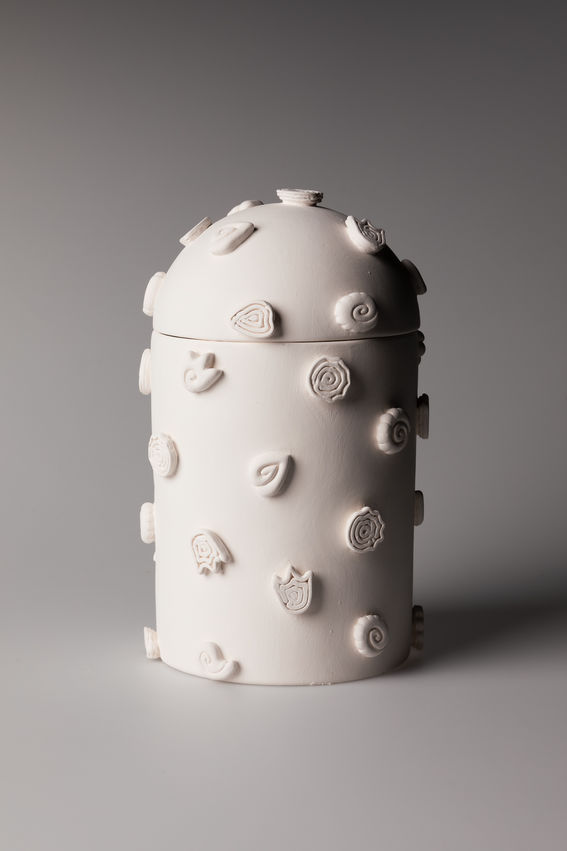
Nina Naveršnik - A tea box
A tea box is an echo of the stories my grandmothers told me and the memories I hold of my great grandmother's garden. It is a tool for me to understand more of who I am as a creative and to remind myself that following your joy is the way to live life.
~
Normally I look for purpose in everything I do, but in this project I explored what happens if I put functionality at the back of my mind and let my hands make decisions, not my mind.
It all started as an exploration of my origins. Flowers are the first thing I think of when thinking about my family origins. My mother and both my grandmothers and great grandmothers have big and beautiful flower gardens. Especially on my mother's side of the family there has been a long tradition of knowing and making tea using wild flowers.
My grandmother describes her childhood memories of her mother's flower garden almost as something sacred. The more I spoke with my family, the more certain I was that nature, flowers in particular, deeply spoke to my ancestors' longing for beauty. In the book The Unknown Craftsman, Soetsu Yanagi writes: “In understanding beauty, intuition is more of the essence than intellectual perception.” Flowers in this project were very much an intuitive choice for me.
A tea box is an echo of the stories my grandmothers told me and the memories I hold of my great grandmother's garden. It is a tool for me to understand more of who I am as a creative and to remind myself that following your joy is the way to live life.
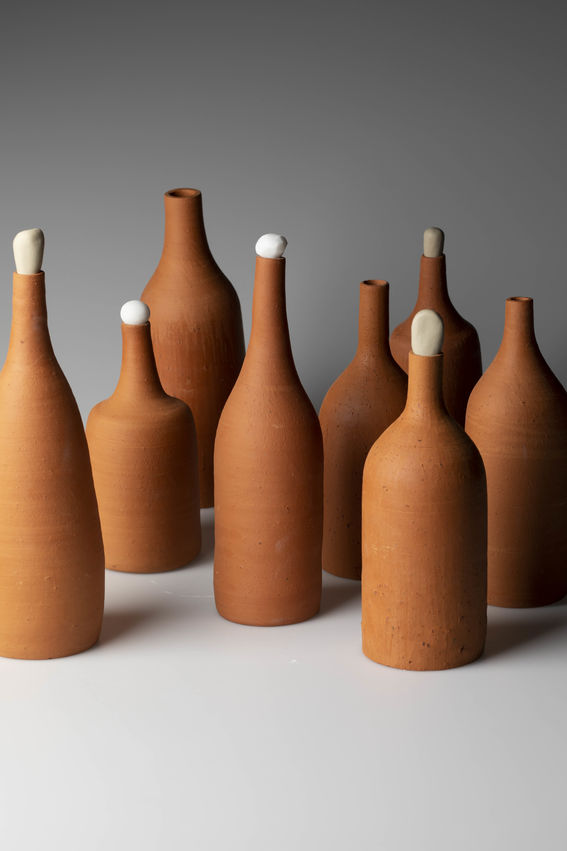
Emilie Tuuminen - Bouteille à la mer
I wanted to send myself a message in a bottle as a reminder from meaningful and happy memories from my past, so that I could always remember those good moments.
~
I approached the theme ‘Origins’ by memorizing important and meaningful moments from my past. Moments of seeing and recognizing myself. Moments and feelings where I have seen myself from a distance, where I have caught myself filled with happiness and infinite possibilities. Those moments often appear when I’m fulfilling my dreams. I wanted to send myself a message in a bottle as a reminder from those meaningful and unforgotten feelings that have come to me and will never leave, bottled memories of happiness.
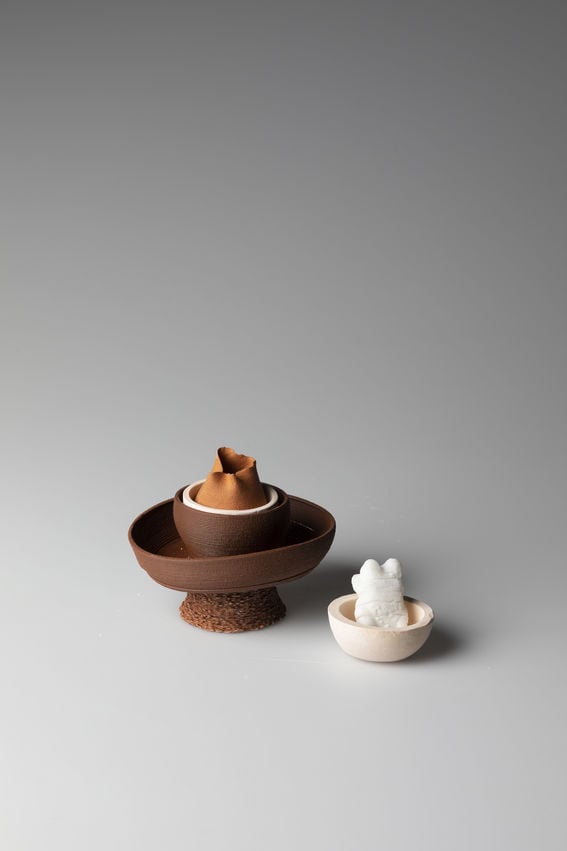
Elise Piquemal - 0
Pedestal: 3D-printed Finnish red earthenware clay, inspired by kinindai, a worship artifact used in chado, the Japanese tea ceremony.
Egg: Hand thrown eggshell porcelain. Made of ‘The HEALER,’ an auto-destructive ceramic material developed with Tomi Pelkonen and the kind collaboration of the A-bloc Fazer Cafeteria employees.
~
In the dusky and silent ether, a mysterious blast suddenly arose. The explosion, in a blazing gesture, created an ellipse containing the combination of possibles. 0 had no body, no will. 0 was governed by chaos. 0’s elements floated freely within the laws of physics. Until slowly, a shape began to loom. From north and south, up and bottom, material collided.
0 had a form. In the shape of an egg, the grave forces of growth and death, chaos and order, collected the gems for life to emerge. Amassing matter, layers of soil, generations of being. Cultivate, cherish, worship. Using 0’s nature to make and pass on their existence. 0 took the shape of a human for other humans. They would call 0 many names. 0 was to become the mother of all. She grew into a throbbing and shimmering flame. Swollen in her heart. A brisk shell ready to release what was built up inside, and the treasured energy manifested into being.
Where is 0? In intuition. In the artifacts left from ancient cultures. In the humble materials, the transience of life. In Love.
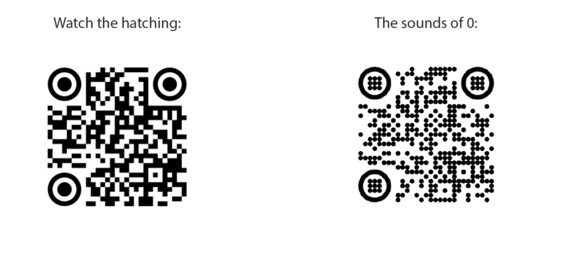
What is Inside?
The hen or the egg?
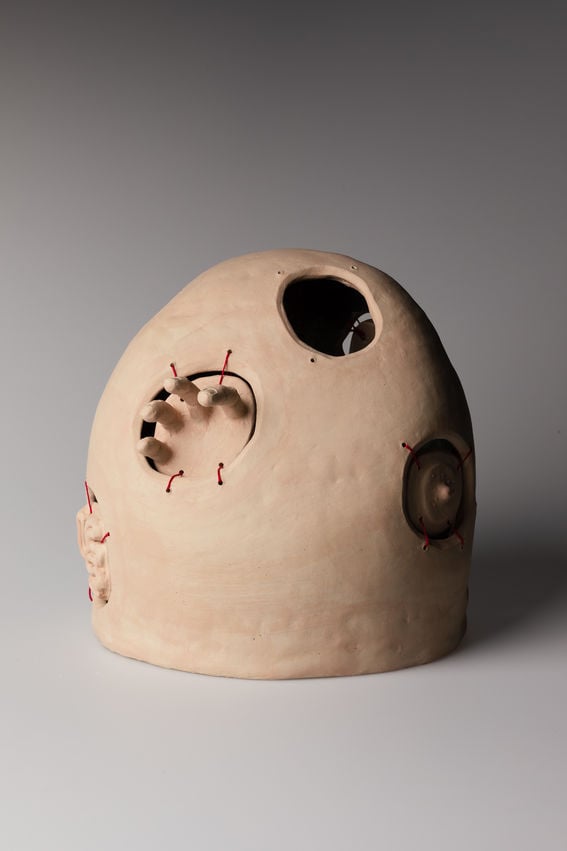
Ruut Launo - Claybody
A portrayal of a human being. A creature trying to appear like others on the outside to hide the inner self.
~
Claybody represents human character development. Originally we are more open and generally showing more of ourselves, showing more of what there is inside us. But growing up makes us want to portray ourselves in a certain way. It makes us want to control the way we are seen by other people. We want to be seen in a way we maybe see other people, or in a way we think is suitable for a human to be. Bit by bit, we cover up more of what is inside us in order to appear human or more acceptable or more like what we think people are supposed to be like.
Inside the body there is a soul. Soul is the part of us we can't see by eye. Still, it's kind of visible and present in us. Our soul makes us more than just a physical being. It's the part of us that is, maybe accidently or by choice, a bit hidden. Sometimes it's easier to be seen as just the physical side of us than to be judged for our inner self.
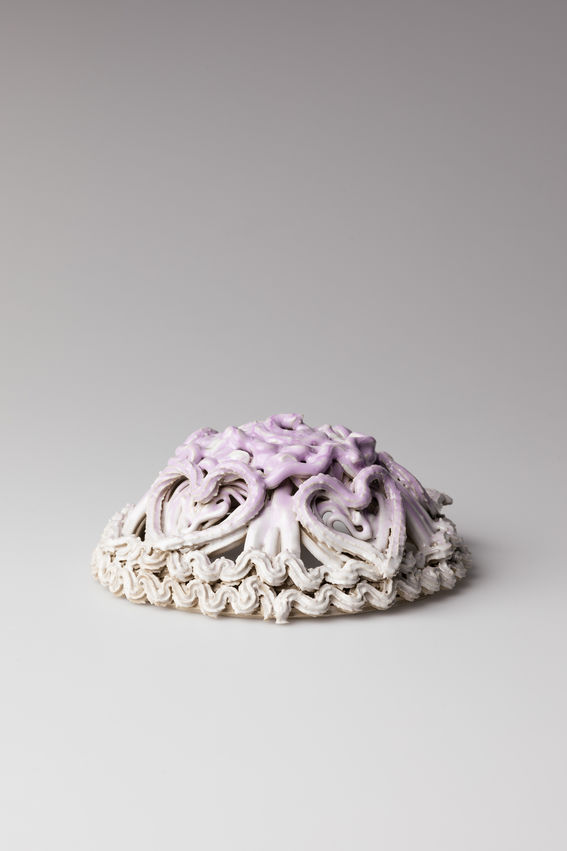
Liv Telivuo - Victor
Victor is part of a series of objects inspired by a recording from 1963 of relatives talking over a cup of coffee or tea. Methods: handbuilding and extruding clay with air pressure.
~
The work is the result of getting to know deceased relatives through a recording from 1963. In the recording, a conversation between my grandfather, his wife (my grandmother), and his father (my great-grandfather) takes place in a very light and happy manner. My great-grandfather (Victor) was a Swedish-speaking Finn (like me) but speaks Finnish on the recording. He talks about the prices for bread and butter, what sweet buns he likes and how he eats them, how high the taxes are, and how Finns and Estonians were best brothers (“virolaiset ja suomalaiset me oltiin ihan bästa bror”) in the navy. He tells stories with an accent that brings a smile to one’s face while classical music is playing in the background, and you truly can feel his laughter filling up the room every now and then.
The objects produced are inspired by the mood and of the characters in the recording. The main character on the tape, Victor, is in my work transformed into a hairy, rusty-looking teapot.
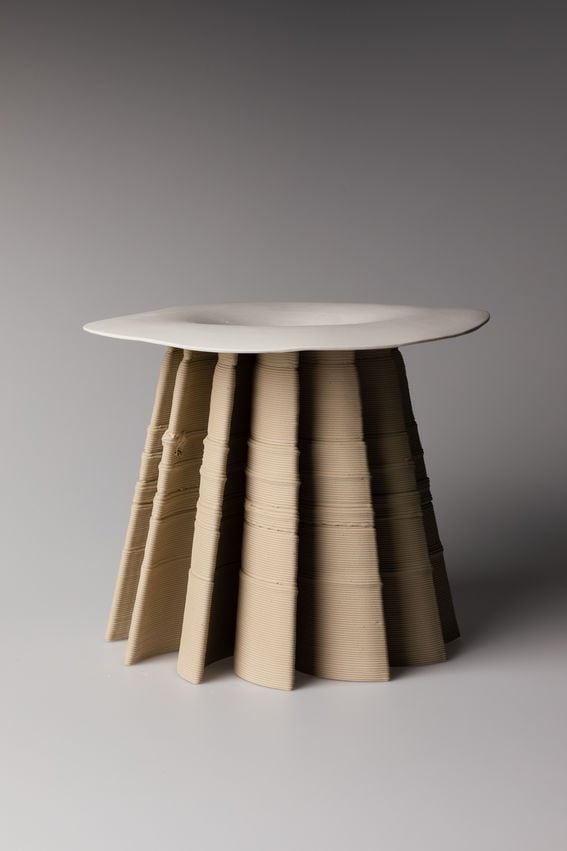
Anton Mikkonen - Chunky
A sculptural tray consisting of a 3D-printed clay base and a slip cast porcelain plate.
~
The core of the course for me was to learn about ceramics and especially 3D-printing clay. These concepts were new to me, and a lot of the design decisions were guided by intuition and the unique qualities of the material, along with the various processes. In working with ceramics, the nature of the material makes the result always in some way uncontrollable.
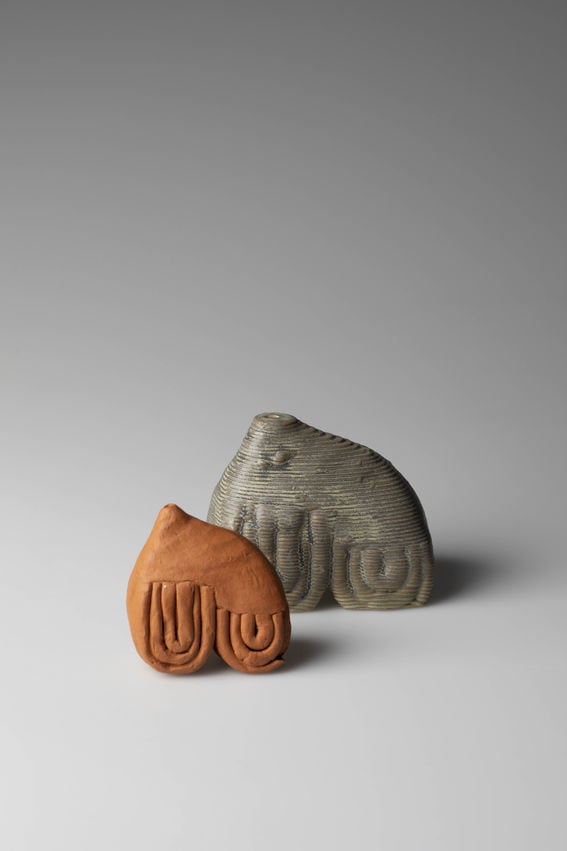
Henriikka Pahkala - My Venus
An intuitive sculpture project where femininity takes on different characters through clay.
~
My Venus is an intuitive sculpture project where femininity takes on different characters through clay. It deals with the change and criticism of my own image of women. A reflection on growing into a woman in a deeply religious family. About the process of opening up, expanding and liberating the ways of thinking. The process was going back to the roots, reuniting important, painful and wonderful events and people of my past. Reflection on how to be appreciative of the past and at the same time break away from it and be myself.
Rigid and angular, closing shapes begin to live and bulge. They take feminine forms and playful directions. At the center of the objects created in the process is a small venus statue in particular, which was initially created as a quick sketch of clay and later got a new design language with a clay 3D-printer. For me, that little statue is a combination of the future and the past.
A tribute to the powerful women of my childhood and to the more equal and liberal femininity of today.
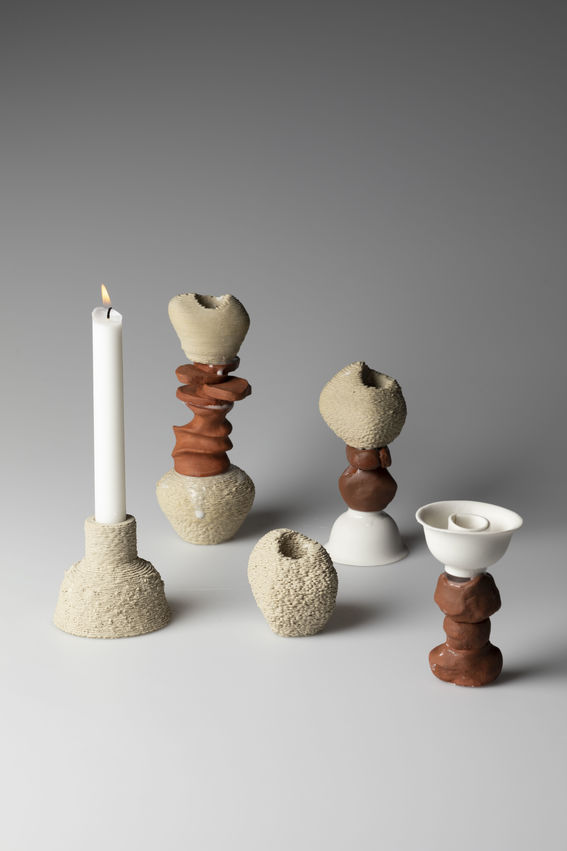
Chien-Chi Kuo - Pile of Memories
The concept of this project is about my origin and roots of my parents’ families (from Da-Chang Island in China and Taiwan).
~
The elements represent my parents’ families (from Da-Chang Island in China and Taiwan). I piled up the pieces to symbolize my roots, and the wax from the candles stand for the experiences I had while growing up. With time, the wax becomes part of the object itself, which represents the process of becoming who I am now.
Different techniques of ceramics were combined in the project including new techniques such as 3D printing with clay, and traditional techniques such as hand-building and casting. 3D printing techniques gave the object a one-of-a-kind texture on the surface. The different moisture of the stoneware, along with the speed and flow of the extrusion affects the final outcome. The elements are made with three types of clay: Finnish earthenware, stoneware and porcelain.
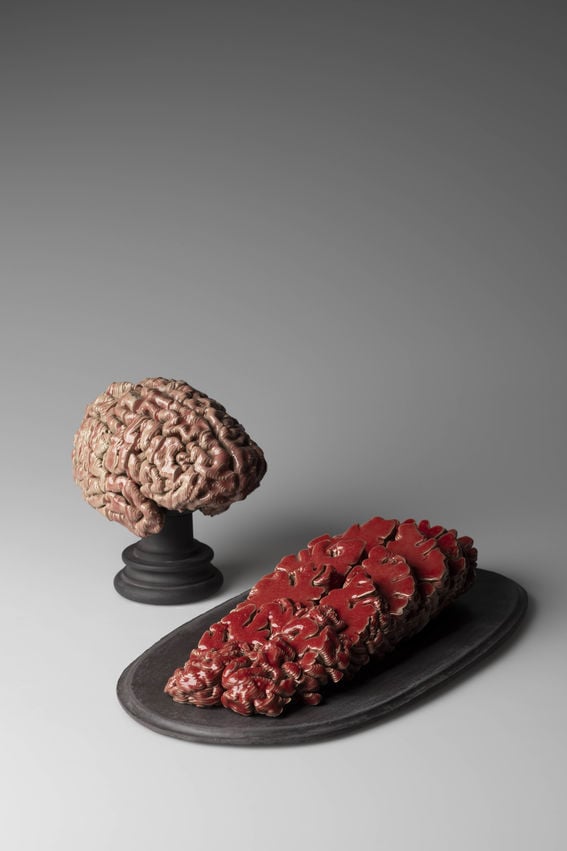
Johannes Kaarakainen - Computer-assisted self-portrait
Each one of us – as an individual personality with unique thoughts and feelings – is essentially a small lump of water and fat, constantly running a series of electrochemical processes that make us who we are. The work is an attempt at creating a sort of self-portrait with the use of data extracted from an MRI scan of the artist’s own brain.
~
In my project I wanted to take a very concrete look into what makes an individual person themselves.
We often focus on our external parts - faces and bodies - when we think of ourselves and other people, look into a mirror, or describe a person to someone else. On the other hand, our personalities and inner selves are commonly seen as something intangible.
But in the end, each one of us – as an individual personality with unique thoughts and feelings – is essentially a brain: a small lump of water and fat, constantly running a series of electrochemical processes that make us who we are. Our limbs, internal organs and other body parts are more or less a mere set of tools for a variety of uses, helping our brains stay alive and functional, to be aware of their surroundings and to allow them to reproduce.
The work is a self-explorative attempt at creating a sort of portrait, that allows for a view into the very core of myself. It makes use of data extracted from an MRI scan of my brain, which was then printed with a clay 3D-printer.
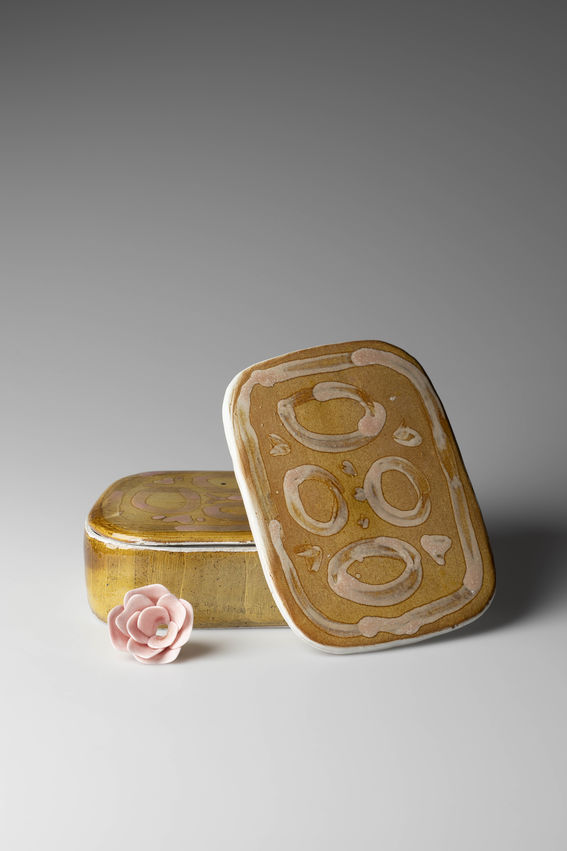
Zoë Robertson - 519 Dreams
519 Dreams is a hand-built ceramic box that, when opened, plays audio of my late father narrating his dreams. The box asks: how do we keep the things we cannot hold, things like our dreams and our dead?
~
When my father died, he left me a USB stick with audio of him narrating his dreams, which he had recorded over the previous four years. His dreams were strange, tender, funny, and absurd. I built a box, originally inspired by traditional Japanese suzuri-bako writing boxes, to hold these dreams. From hours of footage, I created an audio piece narrated by my father, which plays when the box is opened.
While making this box, I considered how memory, experience, and legacy interact. As an object, the box subverts the notion that only a solemn, stoic item – like an urn – can memorialize the dead. Instead, it explores grief through playfulness, wonder, and dynamism. The box asks questions like: When we lose somebody we love, what is important to keep? How do we protect and shelter that?
The rose is 3D-printed using ceramic stereolithography.
The box is hand-built.
Summer day by the ocean. I was on a long, flat, Maine-like beach. The tide was out and a woman was walking in ankle-deep water. She came to a long sandbank and on it there were a lot of sunbathing rock lobsters. She had a bag and selected about ten of them and walked back to shore. Later, I went to the far end of the sand bank and looked for more, but I didn’t find any. That night at supper, there was a big platter of bright-red rock lobsters.
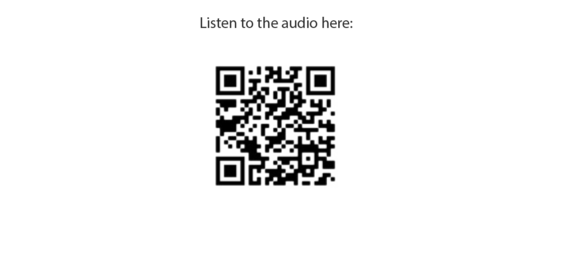
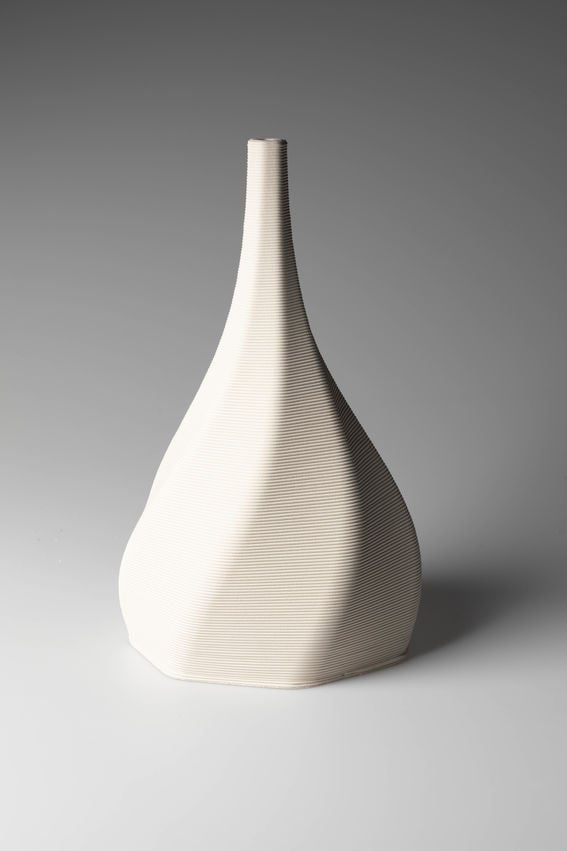
Pegah Shamloo - Mothers and Waves
We all originated from wombs and water.
~
I worked with two major keywords: motherhood and water. When talking about origins, we all indeed originated from our mothers. But in my case, I entirely and truly originated from mine. I was raised by her and I am so similar to her in a way that some people joke about me being a clone. The other important element in my life is water. I spent most of my childhood in a pool that my mom managed. I learned to swim before I learned to walk and even now there's nothing more comforting than swimming. I feel like water is my home. I designed vases as a symbol of wombs and motherhood and holders of water and life. The wavy patterns and forms are there to emphasize the moving and ever-changing nature of water.
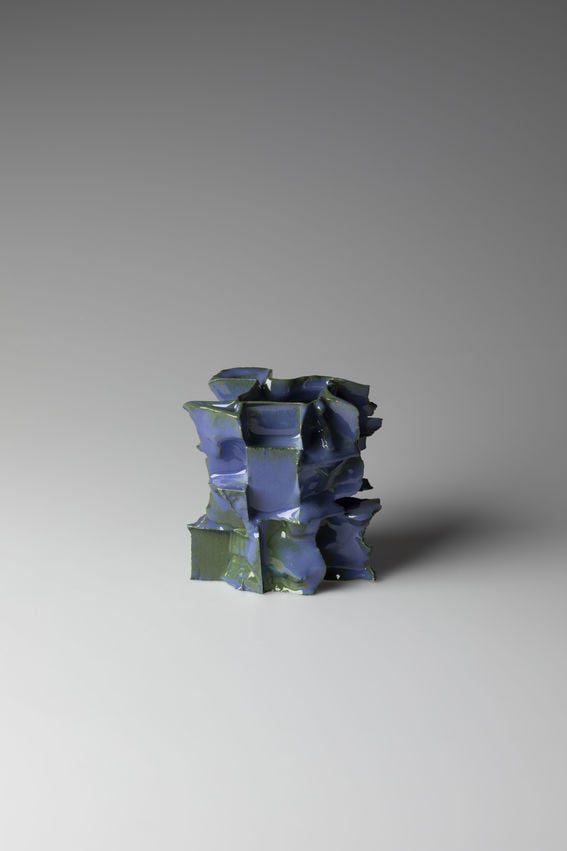
Juan Guevara Verjel - Crumbs, or the Scraps of Autobiographic Memory
Part of a series of porcelain pieces that was developed using reconfigurable molds and 3D-printed ornamental fragments, where jagged shapes are used as a way to reflect on the fickle nature of memory.
~
- Mom, where are the records from my childhood?
- They’re gone.
In reflecting about my origins I think of all the places I have lived and the songs I listened to as a teenager in my bedroom. The birthday parties and the dizzying feeling of being on a bus where the air is thick and humid. Sometimes certain memories jump out when you think about your life, while others fade in the background, almost as crumbs that fell off from the table.
But the more I live, the more I forget, and every container has only so much space. This project came about as a way of coming to terms with how scattered memory is, what it can and cannot do, what it forgets and how it remembers.
“I marvel at (her) ability to place the world within brackets”.
The pieces were developed using a system of modular, reconfigurable molds, where each block could be used repeatedly to give way to different shapes, producing results that vary in complexity and size.
The objects that were there and now are gone became the starting point for the way forms are created. The soft curvature of a chair, the chipped-off edges of the playroom walls and the buildings that I once called home but will never be able to go back to. Was it a flower that I handed to my mother as a child or the odd decoration at the dentist’s office? These material recollections, distorted and repaired, are replicated in a low resolution format that is then printed and placed alongside other fragmented memories.
In the end I’m left to wonder, are there ever enough memories to summarize life?
Course assignment was to design a gift / business gift product concept for Aalto Shop. Students did a preliminary research which led to individual concept ideas. The leading ideas derived from the research were storytelling, affordable price range and locality: how to communicate Aalto university's many aspects like student life, science, learning, art etc. in a gift product. Due to Covid situation the course had a limited time in the studio. Presented concepts are thus still in the concept level, including prototypes, material samples, sketches and drawings which aim to tell you about the idea the the story behind the product.
Students: Shoko Bamba, Taisa Ferreira Ribeiro, Amandine Fong, Shreya Kembhavi, Pasi Kärkkäinen-Tunkelo, Tuuli Latvala, Susanna Partanen, Hannakaisa Pekkala, Hannah Roche, Tatu Rouvinen, Eva Räsänen, George Seppälä, Teemu Siika, Johanna Tarkiainen, Tiia Von Becker, Yikun Wang
Teacher: Eeva Jokinen
Collaborative studio work from MA Architecture and MA Contemporary Design students
exploring the applications of ceramics and clay in the built environment. Working in multi-
disciplinary pairs, participants developed their perception of materiality, scale and space
through the design of burnt bricks, tiles and clay modules, as well as 3D-printing, rammed
earth and clay plaster possibilities in architecture.
The exhibition presents results from the intensive 7-weeks process including 1:1 prototypes
of ceramic and clay surfaces, process work and visualizations of proposed designs in space.
The samples are made in 1:1 scale, surface 500 x 500 mm.
Course Surface and Materiality. Teaching period 28.10.–12.12.2019.
Teachers:
Lecturer Nathalie Lautenbacher (Department of Design)
Associate Professor Jenni Reuter (Department of Architecture)
Senior lecturer Anni Vartola (Department of Architecture)
University lecturer Tuomas Siitonen (Department of Architecture)
Thanks to:
Invited evaluator Kirsti Taiviola
Visiting lecturers Harri Kalha, Kristiina Kuusiluoma, Ashish Mohite, Juhani Pallasmaa
Hosts Paul Lynch/ The Natural Building Company, Karin Widnäs/ KWUM, Kim Simonsson
Studio masters Tomi Pelkonen, Manuel Fonseca, Jari Simanainen
Photos by Anne Kinnunen
Exhibition: TUNTU – TOUCH 24.1. – 7.2.2020 at Beta SPACE, Otaniemi Campus
Master students from different disciplines explored the qualities of ceramics during the course. The restricted brief was to fill a white of black square surface of 600 x 600 x 60 mm with ceramic pieces. The given frames gave students the possibility to dive straightforward into material qualities. Different approaches to the task brought up a variety of results from surfaces to an original mix of new and traditional manufacturing experimentations.
Course Product Design in Ceramics. Teaching period 08.01.—15.02.2019. Contemporary Design, Department of Design.
The course shared the brief and exhibition with Wood Studio Design Project.
Teacher: Nathalie Lautenbacher
Visits:
Kirsi Kivivirta's studio
10 000 Years of Design Exhibition at The National Museum of Finland
Tapio Wirkkala - Rut Bryk Foundation at Emma Museum
Arabia Art Department Society
Photos by Eeva Suorlahti
Exhibition: Väre Main Lobby 01-23.03.2019
Master students from different disciplines explored the qualities of ceramics and glass materials during the course Product and Space Interaction. The restricted brief was to fill a white square surface of 800 x 800 mm with the natural materials, with no colorants added. The given frames gave students the possibility to dive straightforward into material qualities. 16 different approaches to the task brought up a variety of results from subtle glaze surfaces to an original mix of new and traditional manufacturing experimentations.
Course Product and Space Interaction 30.10.—15.12.2017. Product and Spatial Design, Department of Design.
The course was partly conducted in co-operation with Nuutajärvi Glass Village Cultural Association.
Teachers: Kirsti Taiviola, Eeva Jokinen, Nathalie Lautenbacher
Visiting lecturer: Harri Kalha
Studio masters: Kazushi Nakada and Tomi Pelkonen
Glass blower: Janne Rahunen
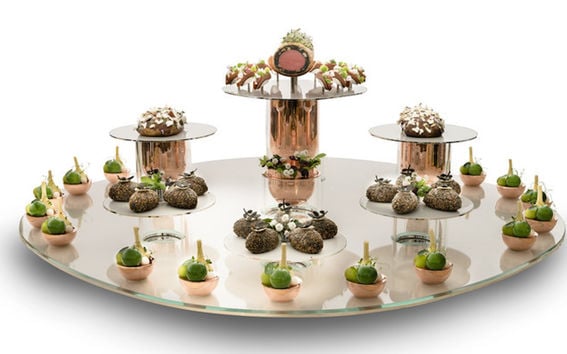
Laura Meriluoto and Klaudia Kasprzak / Bocuse d´Or Competition, Best Platter 2018
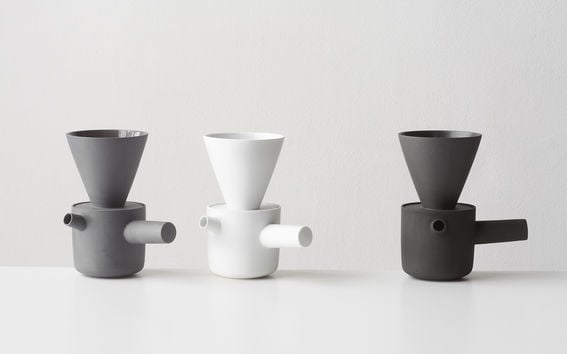
Salla Luhtasela and Wesley Walters / Studio Kaksikko / Muuto Talent Award 2015
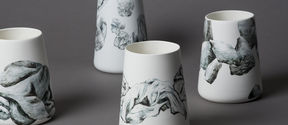
Design students produced a unique collection of ceramic vases for Aalto University Executive Education.
24 Vases in 24 Days Project
Photo Journal from Study Project “24 Vases in 24 Days” in Jingdezhen March-April 2018
"The task was to design and produce a series of unique ceramic objects to be used in Aalto EE premises in Helsinki. The students kept a photo journal during the process to capture their experiences and different working stages in a new environment for all of them".
06.06.2918